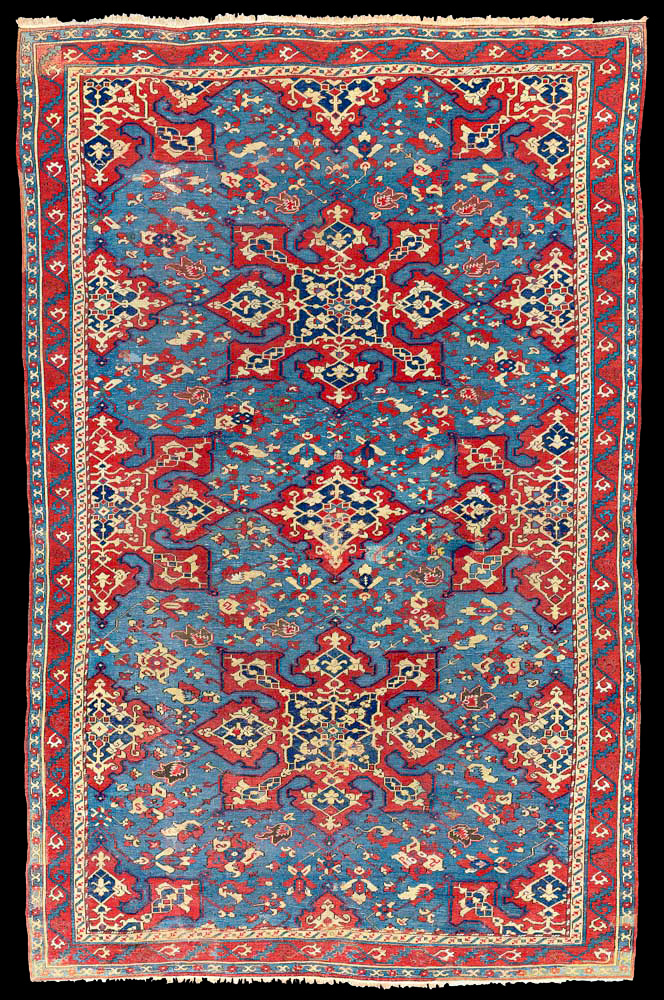|
Yıldızlı Uşak halısı (Star Ushak rug), XVI (16th) century, Turkey, Ottoman Empire.
A 'STAR' USHAK CARPET
WEST ANATOLIA, LATE 16TH CENTURY
Price Realized £86,500 ($143,676)
Estimate £70,000 - £100,000
($115,920 - $165,600)
Sale Information
Christies SALE 1519 —
ORIENTAL RUGS & CARPETS
8
April 2014
London, King Street
Lot 50
A 'STAR' USHAK CARPET
WEST ANATOLIA, LATE 16TH CENTURY
Localised minor repairs, overall very good condition
10ft. x 6ft.5in.
(304cm. x 194cm.)
Pre-Lot Text
THE PROPERTY OF A PRIVATE FLORENTINE COLLECTOR
Lot 50
Light blue Star Ushak carpets are extremely rare in the the
canon of these iconic classical weavings. With the exception of a fragment
in the Vakiflar Museum, we know of no other examples (Belkis Balpinar and
Udo Hirsch, Carpets of the Vakiflar Museum Istanbul, Wesel, 1988, pl.40,
pp.256-257). These carpets are products of the commercial Ottoman court
workshops in Ushak, West Anatolia from the 15th century. The design is an
endless repeat of star medallions set on floral vine backgrounds which was
a product of the Ottoman court nakkashane, and relates to a number of
other motifs produced there in the 15th century, such as architectural
tile designs (Jon Thompson, 'Carpets in the Fifteenth Century', Carpets
and Textiles in the Iranian World 1400-1700, Oxford, 2010, pp.31-57). Most
Ushak carpets are characterised by a palette of tomato-red, indigo and
yellow, with highlights in the secondary colours of white, green and light
blue. Indigo field Ushak weavings such as those in lots 27 and 96 in the
present sale are a much less common than the habitual red-ground weavings.
However, whilst the field designs are remarkably similar across the group
the use of colour in these carpets is often very playful, creating
startlingly different effects on carpets that share the same cartoon.
The effect and importance of colour in Ushak design can be seen when
the present carpet is compared with the very closely related Star Ushak
carpet in Hali 110, p.94. Apart from a very slight difference in width,
the design of the field it is to all intents and purposes the same and yet
the effect is completely different. There is something especially striking
about the juxtaposition of the light blue and red in our carpet. The
indigo outline around the stars and diamond lozenges surrounded by an
additional outline of red has the effect of creating a profile around the
main design elements which gives a feeling of three-dimensionality. The
biplanar effect is increased by the lack of a clearly defined outline due
to corrosion in the floral vine of the field, the medallions appear to
push forward whilst the floral vines spread out from the two central star
medallions like a star-burst. The archaic main border of the present
carpet is rare and fascinating. It is derived from the curled leaf design
of the Turkmen and demonstrates a shared Turkic ancestry, see lot 90 in
the present sale. There are a number of weavings with related borders such
as the triple Star medallion piece in the Metropolitan Museum of Art, inv.
no. 08.235, formerly in the collection of Wilhelm von Bode (M.S. Dimand
and Jean Mailey, Oriental Rugs in the Metropolitan Museum of Art, cat.73,
p.221), an early 16th century example from the Transylvanian Lutheran
church of Bistrita (Stefano Ionescu, Antique Ottoman Rugs in Transylvania,
Rome, 2005, cat.9, p.84) and a fragmentary rug in the Vakiflar Museum
(Belkis Balpinar and Udo Hirsch, ibid., Wesel, 1988, pl.42, pp.260-261).
Whilst all three of these examples share the same design of confronted
curled leaves or fronds, none of them have the same elegance and movement
of the border of the present carpet. The von Bode carpet has a similar
whimsical use of colour but each of the confronting fronds is depicted in
the same colour rather than ours where there is a juxtaposition of
different colours.
The popularity of these beautiful court carpets
is demonstrated by what was clearly a thriving export market for these
weavings from the early 16th century. A number of Star Ushak carpets
survive in the inventories of the Transylvanian churches and museums of
Romania and they begin to appear in Western paintings in the first half of
the 16th century. The first Star Ushak rug to appear in a European
painting is one of a similar narrow format and eight lobed medallion to
the present lot, depicted under the throne of the Venetian Doge in Paris
Bordone's 1534 painting Fisherman Presenting a Ring to the Doge Gradenigo
(Gallerie dell'Accademia, Venice). Star Ushak carpets also appear to have
been a favoured design of the English King Henry VIII (r.1509-1547) who is
depicted standing on top of a Star Ushak in at least three paintings by
Hans Holbein and Hans Eworth ('Portraits of King Henry VIII', Hali, Vol.3
no.3, pp.176-181).

|

